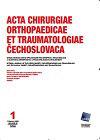Novel Method for Detecting the Stage of Arthrosis and Femoroacetabular Impingement Using a Gyroscopic Sensor and Neural Networks.
IF 0.4
4区 医学
Q4 ORTHOPEDICS
Acta chirurgiae orthopaedicae et traumatologiae Cechoslovaca
Pub Date : 2023-11-11
DOI:10.55095/achot2023/041
引用次数: 0
Abstract
PURPOSE OF THE STUDY Femoroacetabular impingement syndrome is a complex, often post-traumatically developing impairment of the hip joint, characterized by ambiguous symptomatology, which makes early diagnosis diffi cult, especially in the early stages. Experimental retrospective study was carried out to evaluate the usability of a triaxial gyroscopic sensor in routine practice as an additional indication criterion for operative versus conservative treatment procedures. MATERIAL AND METHODS 92 patients were included in the retrospective study, and 62 completed the investigation. All patients signed informed consent. A gyroscopic sensor was placed on the right side of the pelvis above the hip joint, and the patients walked approximately 15 steps. Furthermore, an evaluation of the data during stair climbing and a complete clinical examination of the dynamics and physiological movements in the joint was carried out. Data measured with a gyroscopic sensor were processed using differential geometry methods and then evaluated using spectral analysis and neural networks. The proposed technique of diagnosing FAI using gyroscope measurement is a fast, easy-to-perform method. RESULTS Our approach in processing gyroscopic signals used to detect the stage of arthrosis and post-traumatically developing FAI could lead to more accurate early detection and capture in the early stages. CONCLUSIONS The obtained data are easily evaluated, interpretable and benefi cial in diagnosing the early stages of FAI. The results of the conducted research showed this approach to more accurate early detection of arthrosis and post-traumatically developing FAI. Key words: wearable sensors; osteoarthritis; mathematical biophysics; telemedicine.利用陀螺仪传感器和神经网络检测关节炎和股骨髋臼撞击阶段的新方法
研究目的 股骨髋臼撞击综合征是一种复杂的髋关节损伤,通常在创伤后发展,症状不明显,因此很难早期诊断,尤其是在早期阶段。我们开展了一项回顾性实验研究,以评估三轴陀螺仪传感器作为手术与保守治疗程序的附加适应症标准在日常实践中的可用性。材料和方法 92 名患者被纳入回顾性研究,其中 62 人完成了调查。所有患者均签署了知情同意书。陀螺仪传感器被放置在髋关节上方的骨盆右侧,患者步行约 15 步。此外,还对爬楼梯时的数据进行了评估,并对关节的动态和生理运动进行了全面的临床检查。使用陀螺仪传感器测量的数据通过差分几何方法进行处理,然后使用频谱分析和神经网络进行评估。所提出的利用陀螺仪测量诊断 FAI 的技术是一种快速、易于操作的方法。结果 我们处理陀螺仪信号的方法可用于检测关节炎和创伤后发展 FAI 的阶段,从而更准确地早期检测和捕捉早期阶段。结论 所获得的数据易于评估和解释,对诊断 FAI 的早期阶段很有帮助。研究结果表明,这种方法能更准确地早期检测关节病和创伤后发展的 FAI。关键词:可穿戴传感器;骨关节炎;数学生物物理学;远程医疗。
本文章由计算机程序翻译,如有差异,请以英文原文为准。
求助全文
约1分钟内获得全文
求助全文
来源期刊
CiteScore
0.70
自引率
25.00%
发文量
53
期刊介绍:
Editorial Board accepts for publication articles, reports from congresses, fellowships, book reviews, reports concerning activities of orthopaedic and other relating specialised societies, reports on anniversaries of outstanding personalities in orthopaedics and announcements of congresses and symposia being prepared. Articles include original papers, case reports and current concepts reviews and recently also instructional lectures.

 求助内容:
求助内容: 应助结果提醒方式:
应助结果提醒方式:


